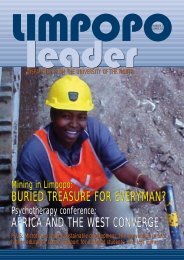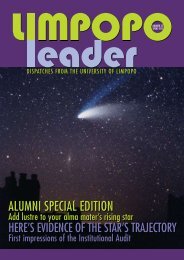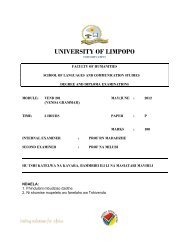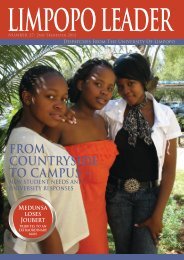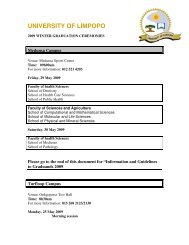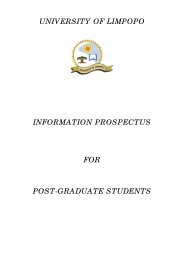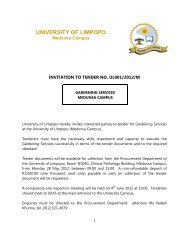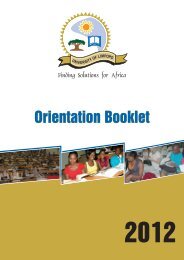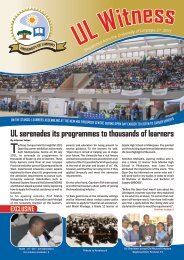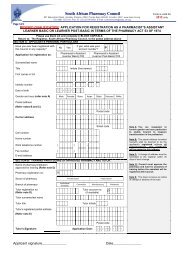Limpopo Leader - Spring 2005 - University of Limpopo
Limpopo Leader - Spring 2005 - University of Limpopo
Limpopo Leader - Spring 2005 - University of Limpopo
Create successful ePaper yourself
Turn your PDF publications into a flip-book with our unique Google optimized e-Paper software.
Dr David Norris<br />
tTO WATCH DR DAVID NORRIS WORKING WITH HIS<br />
CHICKENS IS TO CATCH SIGHT OF A SCIENTIFIC<br />
INTEREST BORDERING ON OBSESSION. He laughs<br />
a lot. He’s an easy man to be around. Yet his focus is<br />
very firmly on his chickens.<br />
‘All these are indigenous African chickens,’ he<br />
says, indicating the scruffy scratching poultry in<br />
several pens on the School <strong>of</strong> Agriculture and<br />
Environmental Science’s experimental farm not far<br />
from the Turfloop campus <strong>of</strong> the <strong>University</strong> <strong>of</strong> <strong>Limpopo</strong>.<br />
‘Those on that side are naked-necked chickens, and<br />
they’re found all over South Africa. These here – the<br />
black and white speckled ones – are called Venda<br />
chickens.’<br />
Nothing much to look at, these indigenous chickens.<br />
A few <strong>of</strong> the roosters have most <strong>of</strong> their tail feathers<br />
missing, and the naked-necked bunch seems vaguely<br />
reminiscent <strong>of</strong> vultures. Yet they have one huge<br />
strength. They’re adapted to local conditions. In other<br />
words, they have developed physiological and<br />
anatomical systems that make any exotic breeds look<br />
positively puny.<br />
‘The imported breeds are especially engineered for<br />
high egg or meat production,’ explains Norris, ‘but in<br />
Southern African conditions they need high inputs –<br />
inoculations, special feeds, and so on – and mortality<br />
rates are high. In other words, they’re expensive -<br />
much too expensive for local conditions. On the other<br />
hand, the indigenous chickens represent a huge<br />
genetic resource. If we’re serious about poverty<br />
alleviation, let’s work with the local stock. That’s the<br />
thinking behind my research.’<br />
Although an estimated 75% <strong>of</strong> South African chicken<br />
production is from local breeds, most scientists are<br />
marginalising the indigenous strains. But not Norris,<br />
who’s a quantitative geneticist at Turfloop. The initial<br />
phase <strong>of</strong> his research was to do a ‘phenotypic characterisation’<br />
study that examined such elements as size,<br />
growth rate, feeding requirements, egg size and output.<br />
‘Because <strong>of</strong> the wholesale neglect <strong>of</strong> the past,’ says<br />
Norris, ‘we know nothing <strong>of</strong> the respective breeds. So<br />
it’s been important to carry out genetic characterisation<br />
that begins to match the external characteristics<br />
with the genetic types. It’s important for another<br />
reason as well. Conservation. We are identifying<br />
and conserving African breeds that have been around<br />
for a very long time but that have almost become<br />
extinct.’<br />
Norris was born and grew up in Botswana, doing<br />
his undergraduate studies at the university in<br />
Gaberone. He then moved to the <strong>University</strong> <strong>of</strong><br />
Reading (in the United Kingdom) and Michigan State<br />
<strong>University</strong> (USA) where he completed his master’s and<br />
PhD degrees respectively. His doctoral thesis dealt<br />
with ‘the dominance effects in genetic variation’.<br />
Norris has also done special courses in quantitative<br />
genetics in the United States (Michigan) and Canada,<br />
and he taught for a period <strong>of</strong> two years at Austin Peay<br />
State <strong>University</strong> in Tennessee. ‘I really loved the Deep<br />
South,’ he recalls. ‘It was so much warmer than<br />
Michigan or Canada – much more suitable for<br />
someone from Southern Africa.’<br />
Norris returned to Botswana in 2000 and made<br />
the move to Turfloop a year later. Asked why, he<br />
replies: ‘I loved the opportunity to combine teaching<br />
and research that Turfloop <strong>of</strong>fered.’<br />
And the marginalised indigenous chickens all over<br />
Southern Africa have benefited. Norris has established<br />
linkages with the <strong>University</strong> <strong>of</strong> Venda, as well as tertiary<br />
institutions in Malawi, Zambia and Zimbabwe.<br />
Relationships are also in the pipeline with Swaziland<br />
and Botswana. ‘These links enable us to exchange<br />
information and research findings on indigenous poultry.<br />
I have also made personal visits. I’m now looking for<br />
funding to more formally establish the international<br />
interactions to cover the whole <strong>of</strong> the SADC region.<br />
This will enrich our understanding <strong>of</strong> a significant<br />
regional resource and improve its utility in our fight<br />
against poverty and under-development.’<br />
Next step in Norris’s indigenous chicken research<br />
is a programme <strong>of</strong> selective breeding to improve the<br />
productivity <strong>of</strong> the chickens without damaging their<br />
adaptability to the environment. At the same time, a<br />
genuine African livestock resource will be conserved<br />
and used as a realistic alternative to much more<br />
vulnerable and expensive breeds imported from<br />
America and Europe.<br />
P A G E 1 5



